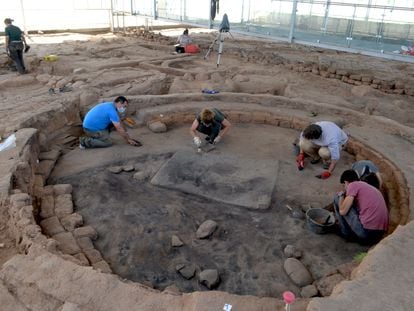Almost forty years have taken the experts to complete the puzzle that made up the different archaeological pieces that they were finding under the hill that currently occupies the late medieval castle of Guardamar, in the Vega Baja of the Segura river (Alicante).
Bronze arrowheads, cauldrons, weights for weaving, votive objects, terracottas of female deities and even a small ceramic plate with two lions attacking a deer, all dating from the Phoenician (8th and 6th centuries BC) and Iberian ( VI BC to I AD).
They had no doubt that both peoples had settled in ancient times on the most outstanding mound on this coast, but they did not understand the function of such diverse elements.
Now, the archaeologists Antonio García Menárguez and Fernando Prados Martínez have given an answer in their study
A Phoenician sanctuary in the castle of Guardamar,
a temple that they have determined was dedicated to the goddess Astarte, the divinity of war, of sexuality, of life, of the seas... "This was the raison d'être of the sanctuary, where the pyre that guided the navigators burned night and day”, they maintain.
In 1986, a team led by Lorenzo Abad, from the University of Alicante, found terracotta cauldrons in the shape of a female head of Iberian origin and that seemed to correspond to a sanctuary.
Between 1993 and 1995, other archaeological teams began to collect data on the walls of the medieval fortress of Guardamar, since the City Council wanted to restore it after its destruction by an earthquake in 1829. Thus, the experts once again came across material evidence of both the occupation Iberian as well as an older one from the Old Iron Age (8th century BC), when the first Phoenicians landed on the Peninsula.
Finally, in 2019, during new archaeological excavations,
Head with Egyptian headdress found in the excavations of the castle of Guardamar.
The hill on which the castle stands rises 64 meters and has good natural defenses on all sides, except for the North, where the slope descends gently until it reaches the course of the Segura.
This topographic configuration guaranteed its defense, as well as turning it into a place with a 360-degree visual domain: the Vega Baja, the bay, the capes of Santa Pola and Cervera, as well as the island of Tabarca.
These conditions did not go unnoticed by the Phoenicians, who chose the knoll as a place to build “a sanctuary that would give protection to navigators or worship deities that should be favorable to them in their colonial enterprise.
Therefore, the role it has played historically for navigation is evident, as it is located at the mouth of the river mouth, like a prominent promontory on the coast.
More information
An Egyptian goddess in Salamanca
But to which god or goddess to dedicate the sacred construction?
The answer has now come by analyzing the excavated archaeological materials.
Among them, a set of elements related to textile crafts, such as a fusayola, a frame and several loom weights.
Researchers believe that "textile manufacturing was a generally female activity that was linked to the cult of the goddess Astarte."
Additionally, in 1999 two Phoenician bronze arrowheads were unearthed on the slopes of the castle.
One of them, double-edged, was used both as a weapon of war and for hunting.
But the second arrow corresponds to a bronze tip with a lanceolate blade.
“Due to its typology, it seems to be a specimen from the Syrian-Palestinian coast with a chronology of the IX-VIII centuries BC.
C.”, indicate García Menárguez and Prados Martínez.
“In the East, these arrows and other weapons were part of the votive deposits that were made in the sanctuaries.
It must have been about religious offerings deposited before the divinity [of Astarte] to reciprocate her protection or, who knows, if to give thanks for having arrived safely after a long and dangerous journey”.
The discovery of a terracotta fragment corresponding to a veiled female figure with a Hathoric hairstyle (female Egyptian deities) and a terracotta head with an Egyptian headdress confirmed the suspicions.
The first is a figure with arms crossed over the chest, almond-shaped eyes and wrinkles on the forehead and ears that refer directly to images of the Phoenician goddess.
It is dated between the 7th and 6th centuries BC.
C. The head, for its part, has a long neck and is dressed in an Egyptian headdress, a hairstyle that also corresponds to the image of the deity.
“These pieces, interpreted as caps for sacred vessels in some cases, were used in oriental sanctuaries as offerings or votive offerings between the 11th and 8th centuries BC.
C. Its long neck, like a stem,
Iberian cauldrons found in the castle of Guardamar.
The authors maintain that the Alicante temple of Astarte did not change its dedication over the centuries, “despite the heterogeneous origin of the sailors who passed through here, the existence of hybridizations or any other type of modification could be assumed.
The sacred value of the place must have remained unchanged for centuries”, although the Phoenician goddess ended up becoming “the feminine divinity of the Iberians, the Tanit of the Carthaginians and a winged goddess of the first moments of Roman rule”.
Astarte, the goddess of the sea, was "Venus, the star that guides the night as it is the first to appear in the sky at sunset: celestial divinity, of war, of navigation and, fundamentally, of fertility and love. carnal, but also the magical and sacred use of water”.
And they conclude: “In the area close to the site, no large urban structures are known until the 3rd century BC.
C, precisely because the center was the sanctuary itself, which functioned as the main cohesion space of the region”, and all presided over by the patron goddess of the navigators, whom everyone had present while the pyre burned.

